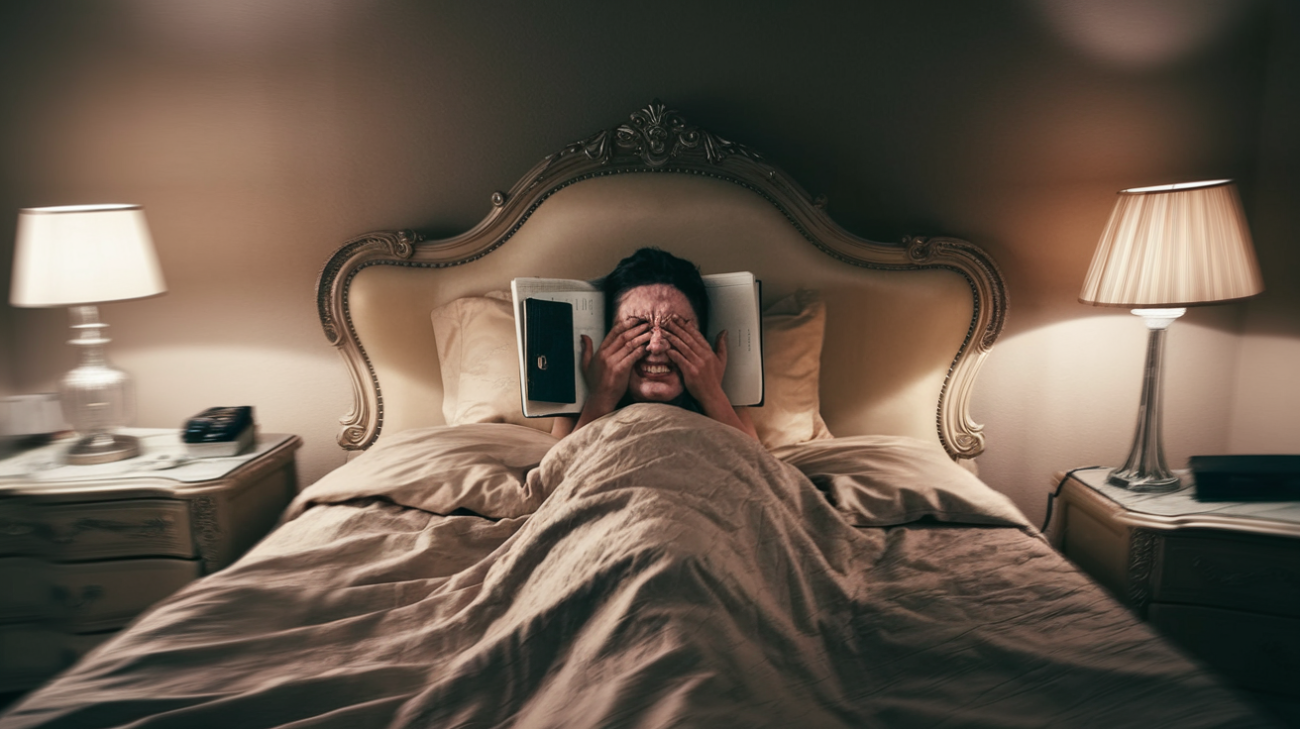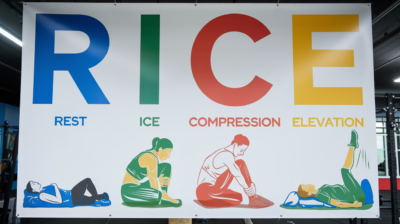
How Chronic Pain Affects Sleep and Anxiety?
Chronic back pain and sleep disorders form a vicious cycle, significantly impacting both disability rates and workplace productivity. According to the National Institute of Neurological Disorders and Stroke, back pain is the leading cause of disability in Americans under 45, affecting roughly 80% of adults at some point in their lives.
The interplay between back pain and sleep disorders is stark:
- Studies show that 50-80% of people with chronic pain report sleep disturbances.
- Individuals with chronic back pain are 18 times more likely to experience clinically significant insomnia.
This comorbidity takes a toll on productivity:
- Workers with both chronic pain and insomnia lose an average of 5.5 hours of productive time per week, compared to 1.5 hours for those without these conditions.
- The annual cost of lost productivity due to chronic pain is estimated at $299-$335 billion.
- Employees with sleep disorders are 1.4 times more likely to be absent from work and 1.8 times more likely to underperform when present.
People who suffer from chronic pain can get serious mental and physical health problems. People with chronic pain may suffer from depression and anxiety, as well as self-perpetuating insomnia. When someone cannot sleep due to pain, for example, they may become anxious. Sleep problems and depression may make them more sensitive to pain, which increases their sensitivity when they wake up. Here in this article you will read everything that you should know about how chronic pain affects sleep and anxiety and how you can overcome this problem.
Understanding the link between back pain and sleep disorders is crucial for developing comprehensive treatment strategies and mitigating the substantial personal and economic costs associated with these intertwined conditions.

Home therapy for acute or chronic joint pain. Image generated by Rosemary Ingado, PA a long time advocate for patients suffering from chronic pain.
What is Pain?
The feeling of pain is a signal that our nerve receptors send to our brain when we experience something wrong. We can feel acute or chronic pain. Acute pain is that which lasts only for a short period of time, such as the pain associated with a broken bone that later heals. Pain that is chronic refers to chronic recurring pain, or pain that does not go away after a short period of time. Chronic pain includes lower back pain, headaches recurrent, fibromyalgia, arthritis and cancer pain. A number of factors determine how our minds interpret pain, including factors such as our physical health, our mood, and the particular circumstances surrounding the pain. Pain can affect our sleep patterns when it occurs at night. Chronically ill people are probably going to suffer from sleep deprivation for a long time.
A study suggests chronic low back pain may be linked to anxiety-depressive and sleep disorders.1 A poster on the research was presented at the 2024 European Alliance of Associations for Rheumatology (EULAR) from June 12 – June 15 in Vienna, Austria.
Chronic low back pain not only brings a significant economic and social impact but can worsen other comorbidities. Back pain hinders sleep, and in return, poor sleep can impact an individual’s mental health. Insomnia is a common co-morbidity of back pain, and 1 study showed an increase in insomnia symptoms was linked to a 1.40-fold increased risk of back pain, suggesting insomnia was a risk factor for the development of back pain—not the other way around.2
Mayo Clinic shares on its website tips for sleeping positions to take the strain off the back, such as sleeping on your side with a pillow between your legs, sleeping on your back with a pillow under your knees, and avoiding sleeping on your stomach but if you need to can put a pillow under your hips and lower stomach.3 According to the Sleep Foundation, a good sleep position is vital for spinal alignment and a poor sleep posture can increase pressure on the lumbar spine.4
Although back pain has been acknowledged to impact sleep and mental health, investigators, led by Leila Rouached, from the Charles Nicolle Hospital in Tunis, Tunisia, aimed to assess the association of chronic low back pain with sleep and anxiety-depressive disorders.
Rouached and colleagues conducted a cross-sectional study in the rheumatology department of Charles Nicolle Hospital from November 2022 to December 2023. The team assessed for anxiety-depressive and sleep disorders using the Hospital Anxiety and Depression Scale (HADS) and the Pittsburgh Sleep Quality Index (PSQI), respectively. A PSQI score of ≥ 5 indicated poor sleep quality.
The study included 85 male patients with chronic low back pain. Patients had a mean age of 53 ± 13 years and a mean disease duration of 1 year. The sample included 42% sedentary patients and 57% smokers with an average of 23 pack-years.
Most patients (60%) had low back pain with radiculopathy. Among the participants, the S1 (31%) and L5 (27%) nerve roots had the most involvement. Abnormalities responsible for low back pain or lumbosciatica included staged degenerative discopathy (32%), disc herniation (28%), the narrow lumbar canal (15%), scoliosis (9%), Scheuermann’s disease (3%), and vertebral fracture (2%).
The team assessed pain with the visual analog scale and neurologic pain with the DN4 score. Participants had a mean visual analog scale of 60 out of 100 and a mean DN4 score of 2.1 out of 8.
Investigators observed anxiety in 40% of patients and major depressive syndrome in 27% of patients. Additionally, a mean PSQI score of 9 out of 21 indicated a patient had a sleep disorder.
The analysis showed anxiety-depressive disorders in patients with low back pain were linked to the sedentary lifestyle (P = .03) and smoking (P = .01). Sleep disorders were significantly correlated with pain intensity (P < .01) and neuropathic pain (P = .05). Additionally, HADS and PSQI scores were significantly correlated (P < .01).
“In our study, chronic low back pain may be associated with anxiety-depressive disorders and sleep disorders,” investigators concluded. “The management of these patients involves systematic screening for these comorbidities to reduce their psychosocial impact.”
How Chronic Pain Affects Sleep?
For your body to perform well, you must get sufficient sleep. When you suffer from chronic pain, however, sleep can become difficult. As many as 67%-88% of all chronic pain patients suffer from sleep disturbances. The term ‘sleep disturbance’ is used to describe all types of sleeping difficulties. Chronic pain patients commonly suffer from insomnia, hypersomnia, restless leg syndrome, and sleep apnea. Sleeping difficulties make dealing with pain even more difficult, creating a vicious cycle. Sleep disturbances associated with pain are more likely to occur the next evening, and so on. Stress on the nervous system caused by insufficient sleep can exacerbate pain. Pain signals are amplified by this kind of stress.
Different Ways Chronic Pain Affects Sleep
Insomnia 50% of people with insomnia also suffer from chronic pain. When you don’t sleep enough on a regular basis, you suffer from insomnia. It’s usually either difficult to fall or stay asleep. Sometimes, people have trouble with both. In pain patients, insomnia can be caused by: ● Anxiety ● Pain ● Regulating body temperature ● Daytime sleeping. A side effect of painkillers is causing patients to sleep during the daytime and have trouble regulating their body temperatures. Sleep disorders are best treated through cognitive behavioral therapy (CBT). Using this practice, the sleep cycle can be broken and new associations can be created with sleeping.
The goal of cognitive-behavioral therapy is as much to assist patients in managing their pain on their own as possible, returning to daily activities, and improving their current quality of life. COBT is commonly utilized in collaboration with chronic pain rehabilitation programs. An important component of pain management is to reduce any stressors related to chronic pain, such as anxiety and depression, in order to reduce any negative effects from living with chronic pain. Restless Leg Syndrome The urge to move your legs uncontrollably is a symptom of Restless Legs Syndrome. Getting comfortable enough to sleep is a challenge due to this condition. Restless leg syndrome frequently occurs in patients with chronic pain conditions. An underlying condition of the nervous system, which is often associated with chronic pain.
Hypersomnia; When people think about sleeping disorders, they typically associate them with lack of sleep. However, this isn’t entirely true. Patients with chronic pain may experience hypersomnia. Patients with this condition sleep too much. Sometimes it is the result of medication or depression. There is a high rate of depression among pain patients. A person experiencing chronic pain may find depression difficult to deal with as the pain can be debilitating, limit their ability to do things they love, or prevent them from being independent. Chronic pain patients are more prone to hypersomnia due to depression.
Sleep Apnea; During sleep, people experience sleep apnea, which causes them to temporarily stop breathing. The most common form of OSAS is obstructive sleep apnea. Are snoring, obesity, type II diabetes, or heart disease the most common causes. The prevalence of OSAS was higher in females than in males, with 55.4% of patients reporting chronic widespread pain. Chronic pain and OSAS are associated with higher levels of pain and a lower quality of life in women. There are various treatments available for sleep apnea including lifestyle changes (for example, losing weight, avoiding alcohol, or quitting tobacco), mouth pieces, or devices such as C-PAPs. You should treat sleep apnea since it can dramatically affect your quality of life. Patients who take pain medication are especially vulnerable to sleep apnea. The relationship between anxiety and chronic pain It is quite possible that anxiety is the most common complication of chronic pain. Anxiety often comes along with chronic pain. It is because pain is a warning signal. As a warning, pain indicates that there is a problem in the body and that attention is required. As such, pain initiates the fight-or-flight response when it is perceived as a warning signal.
In the same way that the nervous system responds to a threat, it responds to pain.
● Feelings of alarm, anxiety, and distress
● Having increased muscle tension, increased blood pressure and heart rate, as well as increased gastrointestinal reactivity.
● Fear of pain and a tendency to worry and fear it as a result of a more acute understanding of the danger
● Guarding, staying home, resting, and avoiding activities that might increase pain are examples of avoidance behaviors. These responses may be quite helpful in acute pain. By correspondingly being scared, you can seek help and guard yourself against further injury. When chronic pain occurs, avoidance and anxiety emerge. The anxiety and avoidance behaviors that occur with chronic pain become chronic in themselves. As a result of chronic anxiety, the patient feels edgy and alarm. The pain sufferer becomes fixated on pain, which preoccupies his or her mental space. Each daily decision seems to be determined by the amount of pain the patient is experiencing at that moment. Chronic muscle tension also contributes to chronic pain. Chronic avoidance behavior leads to social isolation, inactivity, deconditioning, and eventually, disability. Anxiety and chronic pain share a common cause in the nervous system. A persistent state of reactivity has become embedded in the nervous system. As a result, there is often a relationship between anxiety and chronic pain. Chronic pain can lead to anxiety because it is associated with a condition known as ‘central sensitization. Treating anxiety in chronic pain rehabilitation programs Rehabilitation programs for chronic pain are the only treatments that treat anxiety as well as chronic pain. Through such programs, patients learn self-management skills, return to work, and overcome problems such as anxiety. The most effective treatments for anxiety are commonly used in chronic pain rehabilitation programs, including cognitive behavioral therapy, antidepressants, and mild aerobic exercise.The good news is that it’s possible for someone living with chronic pain to overcome anxiety and live well.
Conclusion: It is very important to treat chronic pain immediately and effectively. According to what we discussed earlier, it can damage body cells. Chronic pain can lead to insomnia and anxiety if it cannot be controlled. Chronic pain patients benefit greatly from rehabilitation programs since they learn how to manage their pain and prevent anxiety attacks.
References
- Rouached L, Ben Messaoud M, Bjeoui T, et al AB0155 SLEEP AND ANXIETY-DEPRESSIVE DISORDERS IN CHRONIC LOW BACK PAIN PATIENTS Annals of the Rheumatic Diseases 2024;83:1312.
- Agmon M, Armon G. Increased insomnia symptoms predict the onset of back pain among employed adults. PLoS One. 2014;9(8):e103591. Published 2014 Aug 1. doi:10.1371/journal.pone.0103591
- Sleeping Positions That Reduce Back Pain. Mayo Clinic. Accessed June 28, 2024.
- Suni, E and Iyo J. How to Sleep with Lower Back Pain: Finding Comfort and Relief. Sleep Foundation. April 10, 2024. Accessed June 28, 2024.
- https://www.merckmanuals.com/home/brain,-spinal-cord,-and-nerve-disorders/pa in/overview-of-pain
- https://doi.org/10.1016/j.hoc.2018.01.014
- https://pubmed.ncbi.nlm.nih.gov/30314881/
- https://doi.org/10.5665/sleep.1830 https://doi.org/10.1016/j.pain.2014.04.032
The image created and produced with Ideogram AI by Rosemary Ingado, PA, captures Yogi Topi in a state of deep meditation. This visual representation beautifully illustrates the serene intensity and focus that characterize the practice of African Yoga, showcasing its potential for transformative healing.
Rosemary Ingado, PA – Holistic Health Professional
Rosemary Ingado, PA, is a multifaceted professional blending modern medicine with ancient wellness practices. As a certified Physician Assistant, she brings a wealth of medical knowledge to her work. However, Rosemary’s expertise extends beyond traditional healthcare – she’s also an accomplished outdoorsy explorer, vegetarian, and amateur Yogini, specializing in African yoga.
Innovative Approach to Health
Rosemary’s passion for functional organic holistic well-being is evident in her innovative approach to health and healing. She explores the intersection of Western medicine and Eastern philosophies, often using visual art to convey complex wellness concepts. Her recent foray into AI-generated imagery, specifically using Ideogram AI, showcases her commitment to merging technology with spirituality and health.
Healthcare Treatment
In her role as a Physician Assistant, Rosemary offers a range of healthcare services, including:
- Comprehensive health assessments
- Diagnosis and treatment of acute and chronic conditions
- Prescription of medications when necessary
- Patient education on preventive care and lifestyle modifications
- Coordination of care with specialists and other healthcare providers
Rosemary’s unique background allows her to integrate complementary practices into her treatment plans when appropriate, always in conjunction with evidence-based medical care.
Holistic Wellness Services
Alongside her medical practice, Rosemary offers:
- Coaching for other PAs and NPs in starting their own telehealth practices and billing courses
- Wellness and “healthy eating” guidance, emphasizing food as medicine
- African yoga sessions and workshops
Publications
Rosemary recently published a veggie-powered cookbook titled “Nourishing Your Noggin,” now available on Amazon. This cookbook reflects her commitment to vegetarian nutrition and its impact on overall health and well-being.
Disclaimer
While Rosemary Ingado, PA, is committed to providing comprehensive care that integrates various healing modalities, it is important to note:
- The practice of Topi meditation and other complementary therapies are not substitutes for professional medical advice, diagnosis, or treatment.
- Always consult with a qualified healthcare provider before starting any new treatment or making changes to existing treatments.
- The use of AI-generated imagery in Rosemary’s work is for illustrative and educational purposes only and does not represent medical imaging or diagnostics.
- Rosemary’s approach to integrating Western medicine and Eastern philosophies is based on her professional experience and ongoing research, but individual results may vary.
- In her capacity as a Physician Assistant, Rosemary adheres to all applicable laws, regulations, and professional standards governing medical practice.
Patients and clients are encouraged to discuss any questions or concerns about integrating complementary practices with their conventional medical care during consultations with Rosemary. If you live in Maryland; you may reach her by sending an email to althings.online.
Disclaimer: The views and opinions expressed in Rosemary’s works are solely her own. Althings.online may receive small tokens for the use of her content as an affiliate marketing tool.


